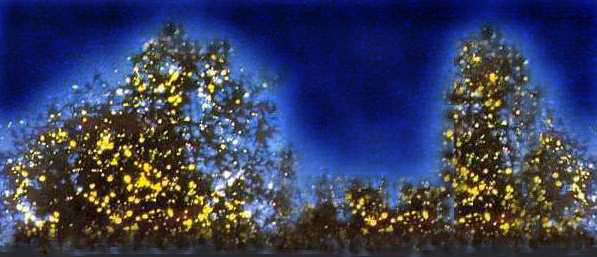|
|
|
|
|
Why are they flashing? Why Synchronised? |
|
To date, all that can be done is to record the actual happening. The sequences and rates of "flashing " . It is established that the male flies around a stationary female. The rate of flashing may attain a speed of 3 flashes per minutes after the warming up period. Ability to generate light Their capabilities to have lights are associated with the bio-luminous elements in their bodies. Such light producing features are present through out the 4 stages of the beetles’ life, eggs, larva, pupa, and adult. While the lights is as the way we see it produced in bulbs or open fire but it is not that kind of light. There are quite a few differences. The first one is, this is a cold light. It has only 10% of its energy expanded in giving that same brightness that we see. The "efficiency" this light is transmitted in a wavelength most sensitive to human eyes. Such perception of brightness had even gives rise to a fallacy and myth that in the olden days students collected some fireflies and kept them in a bottle to be used as a lamp to study. The female has a luminescent organ on it seventh segment while the male has them on the sixth and seventh segments. These segments are supplied with a transparent cuticle [skin like] that acts like glass covers. In the same segments on the inside, the body has a layer of dense tissue that reflects lights. At the appropriate moments, an enzyme or chemical called luciferase is released. The insect's respirtory system supply air to these segments containing the enzyme and an oxidative process -luciferin is triggered. The resulting oxyliciferin is produced and the by-product light is seen. This residue then breaks down and the process is repeated. In the night, it can be said that all the energies are diverted to giving out light
The lights that we see are actually expanded energy that appear in a form of light source. Fireflies with the most brilliant lights can be found is a stretch of countries from India, Burma, Thailand and Malaysia. Flashing of the lights. Almost all fireflies flash their lights. It is synonymous with the beetle. This species seen in the estuary of the Selangor River is slightly different - it does more than mere flashing. It belongs to the group that also practice synchronized or rhythmic flashing. The species had been spotted the area, from the Indian sub-Continent and places east of it. Then down to South and as far east as up to the Philippines and New Guinea.
|
 |
|
The flashing pattern The female will remain stationary usually at the tip of leaves while the male hover around them, said to be in a "J" pattern. Female flashes in a slower rhythm as compared to the male. The flashing pattern following that of the female is slow at the beginning. It will then gradually build up to the peak of 3 flashes per seconds after a period of 40 minutes. It has being observed that this rate will be maintained in that level for the early part of the night. Then the rate of pulsating will gradually slow down but still remain visible until near midnight. After this peak period, both the lights also intensity, diminish significantly. This slow phasing out continues until the early hours of dawn. The beetle will remain in the tree till an hour after dawn. This is a scene that had being observed - beyond that this physical fact, the actual reason or reasons that triggers the start and the synchronization etc are still mysteries.
|
|
Some speculations! The female will respond to the male’s flashing at her fancy. It is not known as to what influences her choice of decision. The respond trigger off a change with increased rate of rhythm from the male. The female counter responded with variation in intensity and speed. With the speed of flashing from the selected pair increases, other males who are not involved with the courtship will start going into rhythm with the leaders. The phenomenon of mass synchronized flashing becomes catchy when the colony of fireflies present is large. One thing leads to another and soon the whole community is in harmony. Another observation, on trees that are sparsely occupied, the rhythm of flashing is less consistent. Could it be the contagious effect that governs the co-ordination and competition among the males. Perhaps the nearness and the density could have influenced the various level of this well-orchestrated flashes.
|
|
If you are looking for challenges, this is one field that you can venture into. |
![]()
|
Watching Fireflies in Malaysia